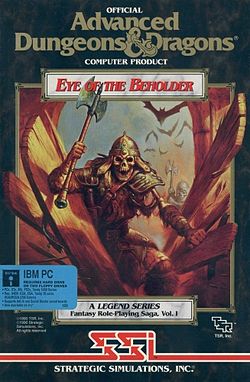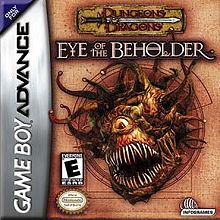- Eye of the Beholder (video game)
-
Eye of the Beholder 
Developer(s) Westwood Associates Publisher(s) Strategic Simulations, Inc.,
Capcom (SNES),
Sega (Sega CD)Composer(s) Yuzo Koshiro (Sega CD) Platform(s) DOS, Amiga, Sega CD, SNES Release date(s) 1990 (PC),
1994 (SNES, Sega CD)Genre(s) Computer role-playing game Mode(s) Single player Rating(s) RSAC: V2: Humans killed (Eye of the Beholder Trilogy, 1995) Media/distribution Floppy disk, CD-ROM System requirements For original version: IBM PC compatible computer with 640KB system memory (565,000 bytes free); either a hard drive with 2.1MB free space or two floppy drives (5¼-inch or 3½-inch, depending on game version purchased) ; VGA, MCGA, EGA, Tandy 16 Color , or CGA graphics capabilities; for optional sound support an AdLib or SoundBlaster board, or built-in speaker; mouse optional.
Eye of the Beholder is a role-playing video game for computers and video game consoles developed by Westwood Studios. It was published by Strategic Simulations, Inc. in 1990 for the DOS operating system and later ported to the Amiga, the Sega CD, and the SNES. The Sega CD version features an exclusive soundtrack composed by Yuzo Koshiro.[1] A full port to the Atari Lynx handheld was developed by NuFX in 1993, but never officially released.
The game had two sequels, Eye of the Beholder II: The Legend of Darkmoon, released in 1991, and Eye of the Beholder III: Assault on Myth Drannor, released in 1993. The third game, however, was not written by Westwood, who had split with SSI over artistic differences and created the Lands of Lore series.
Contents
Story
The lords of the city of Waterdeep hire a team of adventurers to investigate an evil coming from beneath the city. The adventurers start in the city's sewer, whose entrance gets blocked by a collapse caused by Xanathar, the eponymous beholder. The team descends further beneath the city, going through Dwarf and Drow communities, to Xanathar's lair, where the final confrontation takes place.
Once the eponymous beholder was killed, the player would be treated to a small blue window describing that the beholder was killed and that the adventurers returned to the surface where they were treated as heroes. Nothing else was mentioned in the ending and there were no accompanying graphics. This was changed in the later released Amiga version, which featured an animated ending.
Sequels
Eye of the Beholder II: The Legend of Darkmoon
Eye of the Beholder II: The Legend of Darkmoon used a modified version of the first game's engine, added outdoor areas and greatly increased the amount of interaction the player had with their environment, along with substantially more 'roleplaying' aspects to the game.
The Storyline: After the adventures of the first game, the heroes head to a local inn to rest and enjoy their new found fame but a note gets slipped to them from Khelben "Blackstaff" Arunsun (Archmage of Waterdeep) who says that he sent a scout (Amber, a female elven thief/mage of neutral good alignment) to investigate reports of evil brewing in a temple known as Darkmoon but she has not returned. Khelben then transports the heroes to the temple to find Amber and continue the investigation, but it soon becomes apparent that not everything is as it seems....
The gameplay remains within the confines of the temple but players have to explore the vast catacombs beneath, the upper levels of the temple, and the three towers...azure, silver and finally crimson where they can fight the evil Dran Draggore. Like the first game in the series, this one was also ported to the Amiga systems.
Eye of the Beholder III: Assault on Myth Drannor
Eye of the Beholder III: Assault on Myth Drannor was not developed by Westwood Studios, the developer of Eye of the Beholder and The Legend of Darkmoon, but rather in-house by the publisher SSI. Despite employing an updated version of the engine, interesting and oft-unique NPC selection and welcome gameplay tweaks such as an 'All Attack' button and the ability to use polearms from second rank, it was not well received. Reviews criticized the oversized and maze-like maps, lag issues, unchallenging battles, poorly designed puzzles and uninteresting storyline.[citation needed]
The Storyline: After defeating Dran the heroes tell the patrons of a local tavern about their success over Dran Draggore and how it saved the town. After that, a mysterious man enters the tavern and asks the heroes to save the ruined city, Myth Drannor, which is ruled by a Lich named Acwellan. The man then tells the heroes that they need to save Myth Drannor by getting an ancient artifact from the Lich known as the Codex. After the heroes foolishly accept the quest, the mysterious man teleports the heroes just outside of Myth Drannor.
The explorable areas include the forest around the city, the mausoleum, and finally the city ruins including a mage guild and a temple.
Collections
Eye of the Beholder Trilogy (1995, SSI) was a rerelease of all the three games for DOS on CD-ROM. They also (as did a number of other AD&D DOS Games) appeared later in Gamefest: Forgotten Realms Classics (2001, Interplay).
Related games
 Eye of the Beholder on the Game Boy Advance
Eye of the Beholder on the Game Boy Advance
Capcom published a SNES version of Eye of the Beholder in 1994.
A game titled Eye of the Beholder was released for the Game Boy Advance that uses a "stripped down version of the 3rd edition D&D rules" with "only four basic character classes".[2] It is not a port of the original game, though it possesses roughly the same plot. It bears stronger resemblance to the original Gold Box games, such as Pool of Radiance.
Eye of the Beholder is similar to the early CRPG Dungeon Master, released in 1987 by FTL Games.[citation needed]
Several modules for Neverwinter Nights have been created by fans as remakes of the original Eye of the Beholder game.[3]
Reception
The original Eye of the Beholder game was reviewed in 1991 in Dragon #171 by Hartley, Patricia, and Kirk Lesser in "The Role of Computers" column. The reviewers gave the game 5 out of 5 stars.[4]
The Lessers reviewed Eye of the Beholder II: The Legend of Darkmoon in 1992 in Dragon #179, giving the game 5 out of 5 stars.[5]
References
- ^ Barton, Matt (23 February 2007). "Part 2: The Golden Age (1985-1993)". The History of Computer Role-Playing Games. Gamasutra. http://www.gamasutra.com/features/20070223b/barton_06.shtml. Retrieved 2009-03-26.
- ^ Kasavin, Greg (18 December 2002). "Dungeons & Dragons: Eye of the Beholder". GameSpot UK. http://uk.gamespot.com/gba/rpg/dungeonsdragonseyeotb/review.html. Retrieved 2008-01-22.
- ^ "NWVault search for 'Eye of the beholder'". http://nwvault.ign.com/fms/AdvSearch.php?cluster=modules&keywords=Eye+of+the+beholder&Results=999999&LevelAll=Yes&PlayerAll=Yes&Screenshots=No&LevelAll=Yes&LevelMin=01&LevelMax=40&PlayerAll=Yes&PlayerMin=01&PlayerMax=64&SubmittedFrom=28-JAN-2002&SubmittedTo=09-MAR-2009&UpdatedFrom=28-JAN-2002&UpdatedTo=09-MAR-2009&sort=Name&dir=ASC. Retrieved 2009-03-08.
- ^ Lesser, Hartley, Patricia, and Kirk (July 1991). "The Role of Computers". Dragon (171): 57–64.
- ^ Lesser, Hartley, Patricia, and Kirk (March 1992). "The Role of Computers". Dragon (179): 57–62.
External links
- Eye of the Beholder at MobyGames
- Interview with the Eye of the Beholder Project for Neverwinter Nights
- Maps of the Super Nintendo version
Categories:- 1990 video games
- DOS games
- Amiga games
- Sega Mega-CD games
- Super Nintendo Entertainment System games
- Game Boy Advance games
- Forgotten Realms video games
- Strategic Simulations, Inc. games
- Westwood Studios games
- Windows Mobile Professional games
Wikimedia Foundation. 2010.
